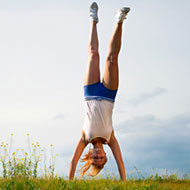- Aromatherapy (36)
- Benefits of Yoga (282)
- Home Remedies (1087)
- massage therapy (9)
- Preventive Therapy (135)
- Running (41)
- Skin Care (15)
- Stress Relief (25)
- Stretching (5)
- walking (33)
- Womens Health (14)
- Yoga Benefits for Pregnant Women (16)
- Yoga Benefits for Students (3)
- Yoga for Children (11)
- Yoga for Holistic Living (37)
- Yoga for Midlife Crisis (3)
- Yoga for Senior Citizens (2)
- Yoga for the Workplace (1)
- Yoga Health Tips (185)
- Yoga Practice during Menstruation (5)
Hand Stand (Mukha Vrksasana) Yoga For Strength, Concentration & Balance

Yoga concentrates on different poses to build strength in different body parts. Each asana has a traditional name which is based on an animal pose and another name which usually describes what your body will be doing in that pose.
In yoga the handstand is called Adho Mukha Vrksasana or the downward tree pose. A handstand is very important in yoga as it denotes the confidence the student has in his or her body. To be able balance your entire body weight on your wrist requires great confidence and great dexterity. Often practitioners of yoga need supervision in breathing during handstands. Doing a handstand on your own usually means that you have broken the novice barrier.
Hand Stand ratifies the Yoga philosophy of balance. Like the Headstand and other balancing postures the Hand Stand also calls for a certain amount of strength, concentration and balance. But, with just a little effort, it is possible to get into the practice, build up confidence and develop the requisite traits to pull off an accomplished Hand Stand. Fear of falling is, unfortunately, the main impediment to even attempting this asana. Then again, fear is only an illusion and, once disregarded, ceases to exist.
1. Start this exercise on all fours, like you would in the Cat Pose, Bidalasana. Next, fold your knees and pull them close to your hands.
2. From here, go into the Downward Facing Dog Pose. To do this, place your body weight on your arms and hands and walk forwards till your buttocks are up in the air and your back is at a slant.
3. With an inhalation, swing your leg up and against the wall and let your lower back follow up. Next, the pelvis goes up, followed by the other leg up to the wall.
4. Now that you have both legs up, take your feet together and gaze at a focal point that will help you to retain balance.
5. See that you maintain your center of gravity between the shoulders in your upper back. Avoid the urge to shift it to your lower back. You could lose balance and even if you don’t fall, you will never be able to get your feet off the wall. Unfortunately, a lot of folks tend to counteract the stiffness in their upper backs by dropping the center of gravity to their lower back .But remember, it is extremely important that you have well balanced alignment for this pose.
6. Once you are well-aligned and you feel that you can maintain your balance, move one leg away from the wall. Hold this pose for a few seconds and when you feel more confident and relaxed, try moving the other leg away, as well. Over a period of time you will be able to do this with ease, with the pose calling for less effort, strength and energy.
A major fear while doing this pose is the fear of falling face forward. You will slowly learn where to maintain the center of gravity so that you do not fall. In the practice of yoga, this handstand has many benefits and tips so that you can do it well. Some of the main benefits are reducing the effect gravity has on the coronary muscle. Decompressing your spine, improving and boosting your circulation, reducing your depression if you have any, improving endocrine function and of course feeling calmer are some of the other benefits of doing a handstand. This pose also, obviously, builds strength in your arms and abdomen.
Benefits Of Hand Stand (Adho Mukha Vrksasana)
- The Hand Stand helps strengthen your arms, wrists, and shoulder muscles
- It also helps stretch the abdomen and improves one’s concentration, coordination and balance
- Through focused effort it helps calm down the brain thereby helping relieve stress and tension and mild depression through the meditative effort involved
Contraindications:
- The Hand Stand is best avoided by those suffering from headaches, heart problems, high blood pressure and during menstruation
- Also to be avoided if you are nursing a shoulder, back or neck injury
An important tip is that if you are a beginner doing it alone for the first time do this pose close to a wall. Use the donkey pose to brace yourself against the wall, till you get the exact pose for the handstand. Then slowly let go off the support of the wall. For the advanced variety, raise both your legs joined from ankles to knees. It is easier to maintain your balance. Another important tip is find a way to build your body into this pose rather than trying to get straight into this pose the first time.
- RSS Feeds -
- All posts
- All comments
- Benefits Of Pincha Mayurasana The meaning of this asana is peacock feather pose. Before displaying the beau...
- Exercises For Toned Thighs Choosing the best exercises to train your inner thighs is very important to i...
- Fitness Exercises When Pregnant Backaches are a common problem during pregnancy. The cause for backaches can ...
- Leg Exercises Most people concentrate their workout on the upper body since it shows notice...